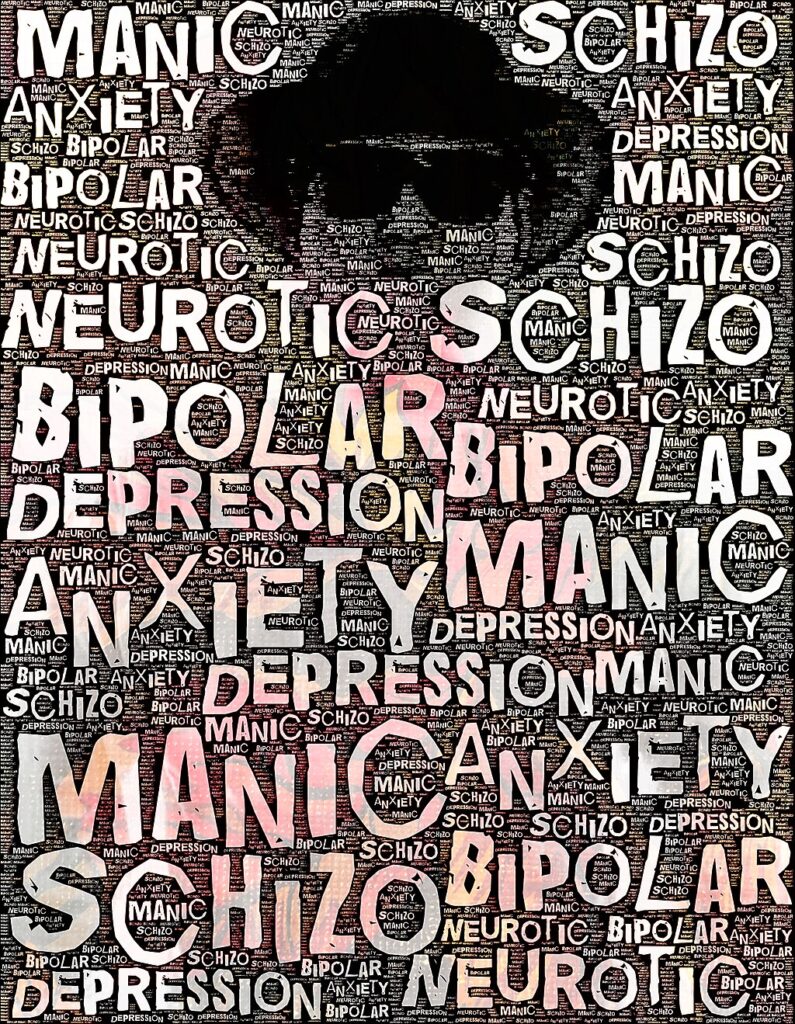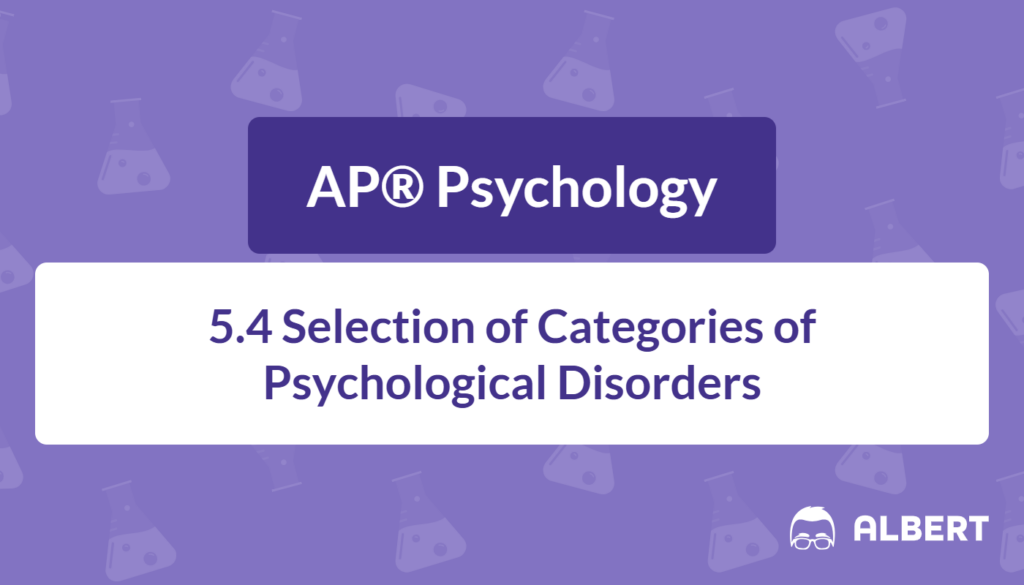What We Review
Psychological disorders can seem overwhelming at first. However, learning the basic categories, symptoms, and possible causes helps in understanding how these disorders develop and how they can affect daily life. This study guide focuses on defining psychological disorders and provides an overview of the major categories of psychological disorders, along with simple examples and short case studies.
Introduction
Mental health issues often begin with subtle changes in mood or behavior. Therefore, recognizing the core features of psychological disorders is important in helping someone find professional support. In AP® Psychology, there are specific categories of psychological disorders to focus on, including neurodevelopmental disorders, schizophrenic spectrum disorders, and more. Each has unique symptoms, possible causes, and patterns of behavior.
Defining Psychological Disorders
A psychological disorder is a pattern of behavior or mental functioning that causes significant distress or impairs a person’s ability to function in daily life. These disorders often involve thoughts, emotions, or behaviors that differ from typical cultural expectations.
- Symptoms can vary widely, from mood changes and anxiety to psychosis and disorganization.
- Possible causes include genetic factors, brain chemistry, environment, learned behaviors, and coping mechanisms.
Categories of Psychological Disorders
When preparing for AP® Psychology, it helps to organize disorders into categories. These are some of the main categories:

- Neurodevelopmental Disorders
- Schizophrenic Spectrum Disorders
- Depressive Disorders
- Bipolar Disorders
- Anxiety Disorders
- Obsessive-Compulsive Disorders
- Dissociative Disorders
- Trauma and Stressor-Related Disorders
- Feeding and Eating Disorders
- Personality Disorders
Each category highlights distinct sets of symptoms and possible causes.
Neurodevelopmental Disorders
Neurodevelopmental disorders begin in childhood and often involve developmental delays or disruptive behaviors. Two common examples are Attention-Deficit/Hyperactivity Disorder (ADHD) and Autism Spectrum Disorder (ASD). Symptoms often reflect whether the person is meeting age-appropriate milestones or not.
Possible causes include:
- Environmental factors (exposure to toxins or infections)
- Genetic factors
- Brain development differences
Example Problem: Case Study on ADHD
A middle school student frequently forgets homework, struggles to sit still in class, and interrupts peers during group activities. The behavior is more pronounced compared to classmates and causes academic issues.
Step-by-Step Solution
- Notice the key symptoms: inattentiveness (forgetting homework), hyperactivity (restlessness), and impulsivity (interrupting others).
- Compare these behaviors with those expected for a student of similar age. Since they exceed typical norms, ADHD is a possible diagnosis.
- Recognize that potential causes could include genetics or exposure to certain environmental factors.
Schizophrenic Spectrum Disorders
Schizophrenic spectrum disorders involve disturbances such as delusions (false beliefs), hallucinations (false perceptions), disorganized thinking or speech, disorganized motor behavior, and negative symptoms (lack of typical functions like emotional expression). Schizophrenia, whether acute or chronic, can severely affect everyday life.
Possible causes often include:
- Genetic predisposition
- Imbalances in brain chemistry (dopamine hypothesis)
- Prenatal factors (virus exposure, complications)
Example Problem: Case Study on Schizophrenia Symptoms
A young adult reports hearing voices that others do not hear and sometimes speaks in disorganized sentences (“word salad”). The individual also shows flat affect, rarely smiling or showing emotion.
Step-by-Step Solution
- Identify positive symptoms: hallucinations (hearing voices) and disorganized speech.
- Recognize the negative symptom: flat affect.
- Conclude that these experiences could indicate a schizophrenic spectrum disorder, likely pointing to schizophrenia.
Depressive Disorders
Depressive disorders include Major Depressive Disorder (MDD) and Persistent Depressive Disorder (dysthymia). They involve ongoing sad or empty moods, lack of motivation, and disruptions in daily life.
Possible causes may be:
- Biological (neurotransmitter imbalances)
- Genetic contributions
- Stressful life events
- Learned helplessness or negative thinking patterns
Example Problem: Case Study on Depression
A teenager has lost interest in hobbies for several weeks, expresses persistent sadness, and experiences changes in sleep and appetite. School performance declines due to low energy.
Step-by-Step Solution
- Note the main symptom: ongoing depressed mood and lack of interest in usual activities.
- Identify additional signs: sleep and appetite changes.
- Recognize the duration (several weeks) and severity, consistent with a depressive disorder.
Bipolar Disorders
Bipolar disorders involve shifts between manic episodes (high energy, elevated mood) and depressive episodes. In Bipolar I Disorder, manic phases are severe. In Bipolar II Disorder, hypomania (milder mania) alternates with depressive phases.
Possible causes:
- Genetic influences
- Neurotransmitter imbalances
- Stress or life changes
Example Problem: Bipolar Cycling Scenario
An individual goes from feeling extremely elated and energetic for a week—needing little sleep, talking rapidly—to feeling very sad and fatigued the following week, doubting their self-worth.
Step-by-Step Solution
- Note the period of mania or hypomania (elevated mood, high energy).
- Observe the subsequent depressive period with low mood and fatigue.
- Conclude that these alternating periods point to a bipolar disorder.
Anxiety Disorders
Anxiety disorders often involve excessive fear or anxiety. Common types include specific phobia, agoraphobia, panic disorder, social anxiety disorder, and generalized anxiety disorder (GAD). Anxiety can lead to physical symptoms like sweating, rapid heartbeat, and restlessness.
Possible causes involve:
- Learned associations (conditioned fears)
- Maladaptive thinking patterns
- Genetic predisposition
Example Problem: Case Study of a Panic Attack
During a crowded school assembly, a student suddenly feels intense fear, heart palpitations, and shortness of breath. The student believes they might faint or lose control.
Step-by-Step Solution
- Recognize the sudden onset of intense fear and physical reactions.
- Identify the random or unanticipated nature typical of panic attacks.
- Understand that repeated panic attacks could form the basis of panic disorder.
Obsessive-Compulsive Disorders
Obsessive-compulsive and related disorders involve repetitive, intrusive thoughts (obsessions) and rituals or behaviors (compulsions) aimed at reducing anxiety. Examples include Obsessive-Compulsive Disorder (OCD) and Hoarding Disorder.
Possible causes:
- Stressful experiences triggering anxious coping
- Learned associations
- Genetic or biological predispositions
Example Problem: Scenario with Compulsive Behaviors
A person feels persistent anxiety about germs (obsession) and washes their hands over 20 times an hour (compulsion) to cope with this fear.
Step-by-Step Solution
- Notice intrusive thought: fear of contamination by germs.
- See repetitive behavior: excessive handwashing.
- Recognize the loop of obsession and compulsion, typical of OCD.
Dissociative Disorders
Dissociative disorders involve a disconnection from memories, identity, or consciousness. Common examples include Dissociative Amnesia (with or without fugue) and Dissociative Identity Disorder (formerly multiple personality disorder).
Possible causes:
- Severe trauma or stress
- Psychological response to overwhelming events
Example Problem: Case Study on Dissociation
An adult experiences sudden memory gaps for personal information after witnessing a serious accident. The person cannot recall key details of their life during a specific period.
Step-by-Step Solution
- Identify memory loss for important personal information.
- Recognize the recent stressful event.
- Understand that this aligns with dissociative amnesia, possibly triggered by trauma.
Trauma and Stressor-Related Disorders
These disorders result from exposure to a traumatic or stressful event. Posttraumatic Stress Disorder (PTSD) is a prime example, involving flashbacks, severe anxiety, and emotional detachment.
Possible causes:
- Experiencing or witnessing trauma
- Chronic stress
Example Problem: Scenario on PTSD Symptoms
A returning soldier experiences nightmares, avoids any reminders of combat, and reacts with extreme alarm when hearing loud noises, such as fireworks.
Step-by-Step Solution
- Acknowledge the history of trauma (combat experiences).
- Identify avoidance of reminders (fireworks) and intense anxiety.
- Recognize these as hallmark signs of PTSD.
Feeding and Eating Disorders
Feeding and eating disorders include Anorexia Nervosa (restrictive eating and distorted body image) and Bulimia Nervosa (binge eating followed by compensation, such as purging).
Possible causes:
- Genetic predisposition
- Cultural pressures and body image
- Cognitive or behavioral factors
Example Problem: Case Study on Eating Behaviors
A student severely restricts calorie intake due to fear of becoming overweight, despite being significantly underweight. Close friends note the student’s refusal to eat regular meals.
Step-by-Step Solution
- Observe restricted food intake and stress over body weight.
- Compare actual weight status (significantly underweight) with the student’s fear.
- Determine that these symptoms align with anorexia nervosa.
Personality Disorders
Personality disorders involve ingrained behaviors and inner experiences that deviate from cultural expectations. They often cluster into three groups:
- Cluster A (odd or eccentric)
- Cluster B (dramatic, emotional, or erratic)
- Cluster C (anxious or fearful)
Possible causes:
- Genetic or biological factors
- Maladaptive patterns formed in childhood
- Environmental or cultural influences
Example Problem: Scenario Depicting a Personality Disorder
An individual who persistently blames others for misfortunes, is extremely distrustful, and avoids forming close relationships due to constant suspicion of betrayal.
Step-by-Step Solution
- Notice long-term distrust and suspicion.
- Identify how these beliefs deviate from typical social behavior.
- Conclude that such consistent patterns fit a Cluster A personality disorder, possibly paranoid personality disorder.
Quick Reference Chart
Below is a quick guide to important terms:
| Term | Definition / Key Features |
| Neurodevelopmental Disorders | Disorders with onset in childhood; involve developmental or behavioral concerns (e.g. ADHD, ASD). |
| Schizophrenic Spectrum Disorders | Characterized by delusions, hallucinations, disorganized speech/thinking, or behavior, and negative symptoms. |
| Depressive Disorders | Marked by persistent sadness, hopelessness, and changes in routine functioning (e.g., MDD, dysthymia). |
| Bipolar Disorders | Experience of manic (or hypomanic) and depressive episodes (e.g., Bipolar I, II). |
| Anxiety Disorders | Excessive fear or anxiety, including phobias, panic disorder, and generalized anxiety. |
| Obsessive-Compulsive Disorders | Intrusive thoughts (obsessions) and repetitive behaviors (compulsions) (e.g., OCD). |
| Dissociative Disorders | Disconnection from memory or identity; often linked to trauma (e.g., dissociative amnesia, DID). |
| Trauma and Stressor-Related Disorders | Psychological distress following a traumatic event (e.g., PTSD). |
| Feeding and Eating Disorders | Altered consumption or absorption of food impacting health (e.g., anorexia nervosa, bulimia nervosa). |
| Personality Disorders | Enduring behavioral patterns outside cultural norms; grouped into Clusters A, B, and C. |
Conclusion
Understanding these categories of psychological disorders, including their symptoms and possible causes, helps in recognizing complex mental health challenges. Each individual’s experience may be unique, but having a solid framework allows students to approach these topics with empathy and knowledge.
Sharpen Your Skills for AP® Psychology
Are you preparing for the AP® Psychology test? We’ve got you covered! Try our review articles designed to help you confidently tackle real-world AP® Psychology problems. You’ll find everything you need to succeed, from quick tips to detailed strategies. Start exploring now!
- Mental Health Service: AP® Psychology Review
- Psychological Evaluation: AP® Psychology Review
- Mind Body Connection: AP® Psychology Review
Need help preparing for your AP® Psychology exam?
Albert has hundreds of AP® Psychology practice questions, free response, and full-length practice tests to try out.








